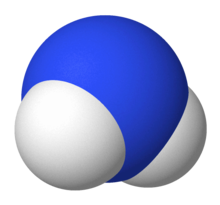
| |
| Names | |
|---|---|
| Pronunciation | /ˈæzənaɪd/ |
| IUPAC name
Azanide
| |
Other names
| |
| Identifiers | |
3D model (JSmol)
|
|
| ChEBI | |
| ChemSpider | |
PubChem CID
|
|
CompTox Dashboard (EPA)
|
|
| |
| |
| Properties | |
| NH−2 | |
| Molar mass | 16.023 g·mol−1 |
| Conjugate acid | Ammonia |
| Structure | |
| Bent | |
| Related compounds | |
Other anions
|
|
Related isoelectronic
|
water, fluoronium |
Except where otherwise noted, data are given for materials in their standard state (at 25 °C [77 °F], 100 kPa).
| |
Azanide is the IUPAC-sanctioned name for the anion NH−2. The term is obscure; derivatives of NH−2 are almost invariably referred to as amides,[1][2][3] despite the fact that amide also refers to the organic functional group –C(=O)−NR2. The anion NH−2 is the conjugate base of ammonia, so it is formed by the self-ionization of ammonia. It is produced by deprotonation of ammonia, usually with strong bases or an alkali metal. Azanide has a H–N–H bond angle of 104.5°.
